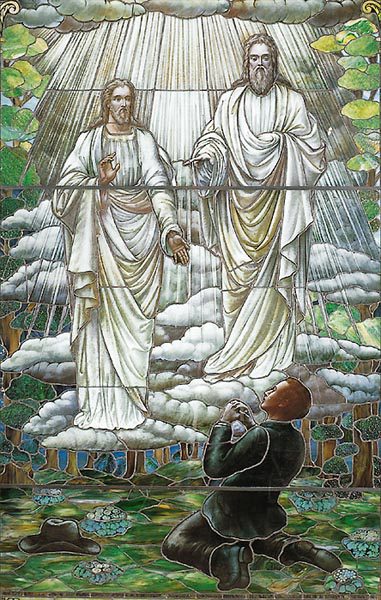
A 1913 stained glass by an unknown artist
(Wikimedia Commons public domain)
I’ve already posted two brief notes in response to the new Church policy regarding children of homosexual couples, here and here.
Since then, I’ve seen some very angry comments from people who, they say, are resigning their membership in the Church over this. Most if not all of them, thus far, have been folks who were already pretty much out of the Church, but I’m still saddened by their decision to abandon their ties altogether. There’s a finality there — never quite final of course, but awfully close — that is regrettable, and that will reverberate for generations in their families.
For myself, I’m reminded of John 6:66-69:
From that time many of his disciples went back, and walked no more with him. Then said Jesus unto the twelve, Will ye also go away? Then Simon Peter answered him, Lord, to whom shall we go? thou hast the words of eternal life. And we believe and are sure that thou art that Christ, the Son of the living God.
To me, to reject the Restoration, with its glorious promises of hope beyond the grave, eternal family unions, and full, exalted fellowship with the Gods, over almost anything short of a conviction that it rests on fraud or madness (neither of which I regard as sustainable) is rather like turning down a billion-dollar inheritance from your uncle because you dislike his taste in clothes, object to the way he talks, or think his jokes are irritating. I want to be with my parents again, and my brother, and my granddaughter. I want to spend eternity with my wife, and in the sweet society of the Saints.
I remain a faithful, committed member of the Church of Jesus Christ of Latter-day Saints because I’m convinced that its claims are true.
Last week, I wrote a column for the Deseret News in which I cited a story brought to my attention some years back by my friend Lou Midgley, which he had heard from the eminent University of Chicago church historian Martin Marty:
The famous 18th-century French hostess Marie de Vichy-Chamrond, the Marquise du Deffand, friend of Voltaire and other leading intellectuals of her day, was conversing with Cardinal de Polignac. He told her that the martyr St. Denis, first Christian bishop of Paris, had taken up his head and walked a hundred miles after his execution. Madame du Deffand replied, “In such a promenade, it is the first step that is difficult.” She meant, of course, that it’s not the claim that St. Denis walked a hundred miles that poses a difficulty. Maybe he really walked only 99 miles. Or perhaps he walked a hundred and two. Such differences mean little. The fundamental question is whether, after his beheading, he walked at all. If that essential point has been granted, the rest is merely a footnote.
In my judgment, if the foundational claims of Mormonism are true, if God really appeared to Joseph Smith and Moroni really delivered Nephite plates to him and Brigham Young really was his legitimate successor, complaints about boring meetings, irritation at Elder So-and-So’s views on evolution or Elder Such-and-Such’s remarks about lipstick or earrings, occasionally awful hymns, a dearth of great Mormon fiction, the cultural expectation of white shirts, and even complaints about this or that church policy are really quite beside the point.
And I’ve concluded that those foundational claims are true.
During the succession crisis that followed the assassination of Joseph Smith, Sidney Rigdon proposed himself as “guardian” for the Church. In response, at a famous meeting in a grove near the Nauvoo Temple, Brigham Young spoke — and, according to many who were there, was “transfigured” before a large audience. That’s a very interesting story. But I want to focus on something that he said:
“Here is Brigham, have his knees ever faltered? Have his lips ever quivered?”
And the fact is that they hadn’t. He wasn’t exaggerating; he had been faithful to the Prophet and to the Church through the rigors of Zion’s Camp, the Kirtland apostasy, the forced evacuation from Illinois, a demanding mission in England, and a host of persecutions, illnesses, and discomforts.
I aspire to be able to say the same thing, even if I never do say it. Not because I’m servile, and certainly not because I’m a hateful bigot, but because, having determined for myself that Mormonism is true and that the Church of Jesus Christ of Latter-day Saints is the Lord’s church, I’ve resolved not to be distracted. I intend to keep my eyes on the ball, on the one question that really matters. And, thereby, on the promises made through the Gospel — greater than any offered anywhere else on this earth.
Back in 1973 April conference, then-Elder Gordon B. Hinckley told of meeting a young naval officer from a predominantly non-Christian country in Asia. During his training in the United States, he had learned about the Church and been baptized and, now, he was about to return to his native country.
“Your people are not Christians,” Elder Hinckley said to the young man. “What will happen when you return home a Christian, and, more particularly, a Mormon Christian?”
“My family will be disappointed,” replied the officer. “As for my future and my career, all opportunity may be foreclosed against me.”
“Are you willing to pay so great a price for the Gospel?” asked Elder Hinckley.
The young man teared up. “It’s true, isn’t it?” he asked.
“Yes,” responded Elder Hinckley, “it is true.”
“Then what else matters?”
With that truth in mind, I find that everything else comes into proper perspective.
















